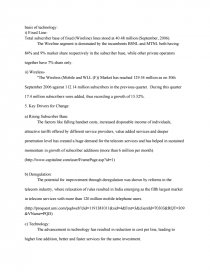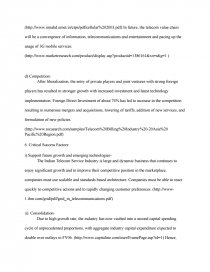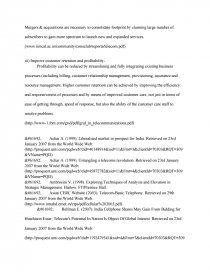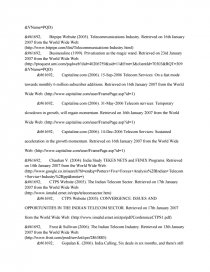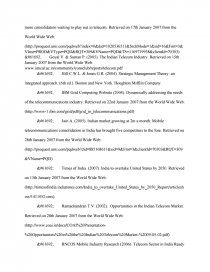Telecom Service Provider (India)
Essay by 24 • May 21, 2011 • 1,362 Words (6 Pages) • 1,532 Views
Introduction:
An Industry where companies are "primarily engaged in operating, maintaining, and/or providing access to facilities for the transmission of voice, data, text, sound, and video" is known as Telecommunications Industry. Hence, Telecom Service Providers are organizations which provide the aforementioned services through the land-line and wireless networks. (http://www.bitpipe.com/tlist/Telecommunications-Industry.html)
Goldman Sachs research says, "India will overtake US by 2050" and the reasons for these predictions are India's increased openness to trade, investment in information and communication technology, and greater financial deepening.
(http://timesofindia.indiatimes.com/India_to_overtake_United_States_by_2050_Report/articleshow/1411052.cms).
These structural changes have had a positive impact on the telecommunications sector so far. The Indian is the fifth largest telecom market in the world meeting up with global standards, (www.iimcal.ac.in/community/consclub/reports/telecom.pdf) but it still remains one of the lowest penetrated markets, and given the string of fovourable and sustainable economic growth, India remains one of the most attractive telecom markets in the world. (http://www.capitaline.com/user/FramePage.asp?id=1)
The gross telephony subscribers : 183.53 million (November 2006)
Teledensity : 16.60% (November 2006)
(http://www.capitaline.com/user/FramePage.asp?id=1)
1. Key Players:
There are three types of players in telecom services:
* State owned companies (BSNL and MTNL)
* Private Indian owned companies (Reliance Infocomm, Tata Teleservices,)
* Foreign invested companies (Hutchison-Essar, Bharti Tele-Ventures, Escotel, Idea Cellular, BPL Mobile, Spice Communications)
2. Division: The Indian Telecom Industry can be divided into two main categories on the
basis of technology:
i) Fixed Line-
Total subscriber base of fixed (Wireline) lines stood at 40.48 million (September, 2006).
The Wireline segment is dominated by the incumbents BSNL and MTNL both having 84% and 9% market share respectively in the subscriber base, while other private operators together have 7% share only.
ii) Wireless-
"The Wireless (Mobile and WLL (F)) Market has reached 129.54 million as on 30th September 2006 against 112.14 million subscribers in the previous quarter. During this quarter 17.4 million subscribers were added, thus recording a growth of 15.52%.
5. Key Drivers for Change:
a) Rising Subscriber Base:
The factors like falling handset costs, increased disposable income of individuals, attractive tariffs offered by different service providers, value added services and deeper penetration level has created a huge demand for the telecom services and has helped in sustained momentum in growth of subscriber additions (more than 6 million per month). (http://www.capitaline.com/user/FramePage.asp?id=1)
b) Deregulation:
The potential for improvement through deregulation was shown by reforms in the telecom industry, where relaxation of rules resulted in India emerging as the fifth largest market in telecom services with more than 120 million mobile telephone users.
(http://proquest.umi.com/pqdweb?did=1191381011&sid=4&Fmt=3&clientId=70303&RQT=309&VName=PQD)
c) Technology:
The advancement in technology has resulted in reduction in cost per line, leading to higher line addition, better and faster services for the same investment. (http://www.iimahd.ernet.in/ctps/pdf/cellular%202003.pdf) In future, the telecom value chain will be a convergence of information, telecommunications and entertainment and pacing up the usage of 3G mobile services.
(http://www.marketresearch.com/product/display.asp?productid=1386161&xs=r&g=1 )
d) Competition:
After liberalization, the entry of private players and joint ventures with strong foreign players has resulted in stronger growth with increased investment and latest technology implementation. Foreign Direct Investment of about 74% has led to increase in the competition resulting in numerous mergers and acquisitions, lowering of tariffs, addition of new services, and formulation of new policies.
(http://www.rocsearch.com/samples/Telecom%20Billing%20Industry%20-20Asia%20 Pacific%20Region.pdf)
6. Critical Success Factors:
i) Support future growth and emerging technologies-
The Indian Telecom Service Industry is large and dynamic business that continues to enjoy significant growth and to improve their competitive position in the marketplace, companies must use scalable and standards based architecture. Companies must be able to react quickly to competitive actions and to rapidly changing customer preferences. (http://www-1.ibm.com/grid/pdf/grid_in_telecommunications.pdf)
ii). Consolidation-
Due to high growth rate, the industry has now vaulted into a second capital spending cycle of unprecedented proportions, with aggregate industry capital expenditure expected to double over outlays in FY06. (http://www.capitaline.com/user/FramePage.asp?id=1) Hence, Mergers & acquisitions are necessary to consolidate footprint by claiming large number of subscribers to gain more spectrum to launch new and expanded services. (www.iimcal.ac.in/community/consclub/reports/telecom.pdf)
iii) Improve customer retention and profitability-
Profitability can be reduced by streamlining and fully integrating existing business processes (including billing, customer relationship management, provisioning, assurance and resource management. Higher customer retention can be achieved by improving the efficiency and responsiveness of processes and by means of improved customer care, not just in terms of ease of getting through, speed of response, but also the ability of the customer care staff
...
...

